Autumn red and gold
Merge into a vibrant pool
Like watercolour


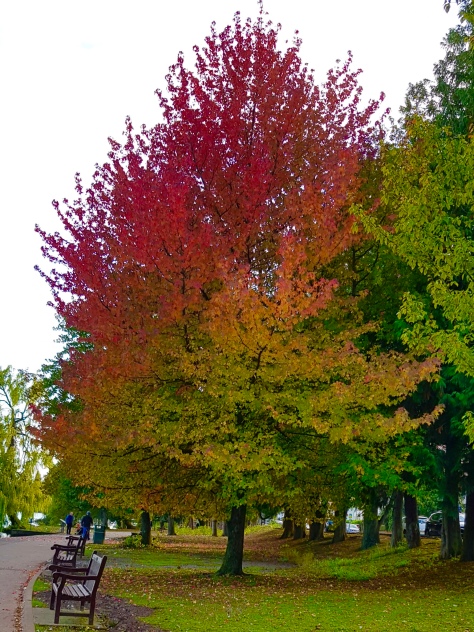

Views from Roath Park, Cardiff
Autumn red and gold
Merge into a vibrant pool
Like watercolour




Views from Roath Park, Cardiff
Fall asleep under an Elder tree in full bloom on Midsummer’s eve and you will encounter fairies & be protected from any evil spirits. The Elder symbolises protection & in Anglo Saxon times it was also believed that if you removed an elder tree from its position a witch would take its place.


Similarly, in ancient myth, fairies are also believed to shelter from harm in the prickly bushes of gooseberries.
So elderflower and gooseberry fruit are a good match and perfect for our home made wine.
The flowers are appearing in abundance now so it is time to collect enough to make a few gallons.


With a fork the tiny creamy white flowers are stripped from the green stalks.


Having a vacuum pack sealer is perfect and they take little room in the freezer where they hibernate until the gooseberries are fully ready in July.

We have a lot of bullfinches who enjoy our gooseberry bushes in Ireland so once the buds show in Early May it needs to be covered.

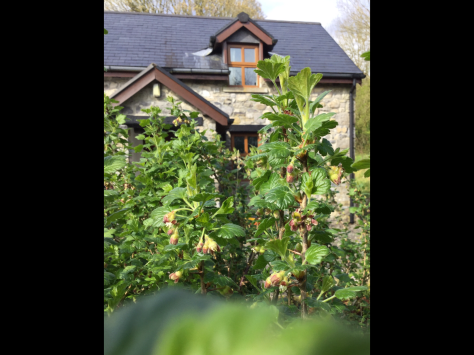
Details to follow on the gooseberry crop & how to process the wine & a tasting of last year’s to follow in the July post.




I just catch a glimpse of a late Spring bluebell.
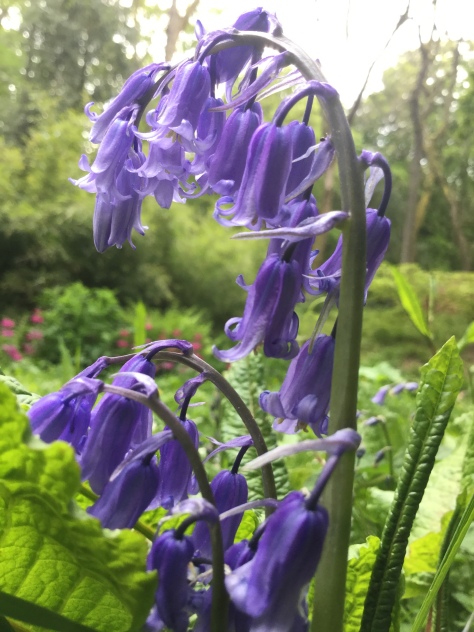
Together with forest flame, azaleas and rhododendrons along the winding paths. As a child I used to thread the fallen pastel & vibrant coloured flowers onto a stick.


The stunning pond iris catch my eye. Bees love yellow – it’s one of their favourite colours (as well as blue, purple, violet and white)

and I have been enjoying the various bee yellow offerings in our gardens in Wales and Ireland …
The Welsh poppies….

Primrose

Gorse

And dandelion

And the centre of this apple blossom

We opened up the hive today and swapped three honey frames from the half brood box with some drawn out empty frames from the honey super above the queen excluder. The main and half brood box are packed so we hope by giving the queen a bit more room to lay she won’t consider swarming this year. So far, so good as for two consecutive years we have had swarms on the same day .May 14th!
Here are a couple of pictures of our hive taken today ..with arum lilies foreground and the bees shining brightly in the May sunshine.



I have had great fun recently melting down the wax gathered from local hives (including our own) to produce a product that is a mix of two loves of mine – bees and cats.
My cat Macy is intrigued by our honey but doesn’t really appreciate the honey bees in her garden.

Having had to sprint (and for a lap cat that is hard…) into the house to escape a low flying guard bee hovering above her tail with its sting poised she is not impressed. She eventually escaped – hiding under the settee – but now creeps past the hives to the back door leading to the alley where she meets her friends and relates the tale of her near escape.
She is very happy to do some promotional work for me though..

She and others understand the benefits of burning beeswax candles – they produce negative ions which help neutralise air pollutants such as dust helping with easing allergy and asthma symptoms.
They are beautiful and natural and are a reminder of the beauty of nature around us.

My gift wrapped macy cat candles and other designs will be making their way across the world to various Beeswax lovers this Christmas.
Get in touch if you would like more info!

It’s been a long Winter in Wales – not rainy and mild like last year but a proper cold Winter with proper snow.

The trees and bees have been delayed, and, like us – particularly with Easter being so early at the beginning of April – have been desperate to move forward into more warmth and sunshine.
The daffodils struggled to appear for Saint David’s day this year. Last year I took a photo of them on Feb 26. This year it was over a month later nearer the beginning of April.

The park’s tulip display was at its’ best on May 6th.

Equally magnificent before Spring’s arrival was this highly ornamental shrub called Stachyurus praexox which was laden with blossom in March.

But then May’s first bank holiday brought hot weather records, flowers and pollen. Everyone and everything burst into bud with renewed energy and now we are enjoying a Spring where everything is playing catch up. This was last week’s beautiful horsechestnut bouquets

and here is a white rhododendron called the ‘Loderi King George’ which Terry Davies planted in Roath Botanic Gardens.


Terry led the 2018 spring Walk in the Botanic Gardens along with Malcom who planted these two Callery Pear trees guarding the entrance to Cathays Library in Cardiff.

The Callery Pear tree in the Botanic Gardens is one of hundreds of Welsh champion trees in Cardiff. It usually blossoms in early spring but is running late. It is more of an ornamental tree as the fruit isn’t edible. Due to its’ beautiful vertical tallness it is perfect for street planting (although In N.E America is considered invasive)


The Botanic Gardens have an interesting history and reading this website – Cardiff Parks – maintained and updated in great detail by Anne and Andy Bell, gives you a great insight into the parks of Cardiff..
One of the original trees planted by William Nelmes in the thirties is the Indian Bean tree on the bridge next to the conservatory in the Botanic Gardens.
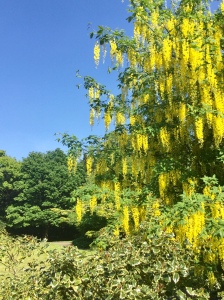
It has a beautiful canopy of foliage and in Summer there are tall white pannicles of flowers. This particular tree doesn’t flower as well now so the Friends of Roath Park who charge a mere £5 membership fee , have planted a young replacement on the river bank opposite. More info here –
https://en-gb.facebook.com/friendsofroathpark/
Our bees in the garden noisily made up for lost time and are now busy foraging and building up their honey stores.we have had to speedily add two honey supers on top of their brood box so they have room to expand and store their nectar. The hot sun directly on the hive means that we have had to increase the ventilation by placing four match sticks between the Queen excluder and first honey box. It will save the bees having to fan quite as much to keep the hive cool.
Not far out from Cardiff is Cosmeston Park.. in the Vale of Glamorgan.
I didn’t spot an otter but they do live amongst the other wildlife on the West Island of the lake that was once a quarry.

But what made my day was this little family gathering!

On arriving in Hong Kong First my first impression is the architectural aesthetics – as I expected but more beautiful than I imagined. The sleek reflecting metallic high rise towers somehow create a feeling of space rather than a feeling of claustrophobia.
 Central Hong Kong graphic skyscrapers
Central Hong Kong graphic skyscrapersThey stand next to well ordered apartment blocks which have air con boxes stacked in neat rows on especially built ledges one under the other all the way to the top. The balconies are sometimes draped with green netting or precarious origami style bamboo scaffolding. There is a lot of new buildings and renovations going n continuously – a sign of prosperity. It amazes me, though, how many middle aged or older female construction workers there are.
 Hong Kong construction
Hong Kong construction Rubber gloves needed
Rubber gloves neededBelow, a child’s toy is amongst the washing dangling outside a window. Diners sit at tables on elongated balconies hundreds of feet up – enjoying their momentary escape from the stress of life below.
 Washing top left
Washing top left Third floor dining
Third floor diningIn Central Hong Kong and along its’ luscious coast from Aberdeen to Stanley there seems to be an emphasis on thoughtful design, a good use of space, pleasing colours and a respect for nature. I read an article in the China Post about the importance of feng shui in the Hong Kong cityscape as well as within properties – I notice lifts always exclude floors numbered 4 or 14 as the word four in Chinese sounds like the word death. It’s a pity I am in room 7 as the word eight is close to the word for fortune in Chinese. The number three is also lucky and groups of three are particularly good. I spotted such a group outside the HSBC building standing next to one of its two lions which are there to guard its’ wealth.
 Checking the markets outside HSBC in Central HK
Checking the markets outside HSBC in Central HKThree is a similar word to birth or life and you can see above how important that might have been in the grouping of buildings in Kowloon as seen from the 100th floor of the International Commerce Centre –
 Groups of three tower blocks
Groups of three tower blocksThe result of Feng Shui being used in creating Hong Kong becomes more obvious as you walk around. You begin to notice the layout of buildings, the sea reflected in windows And big holes in buildings called ‘dragon holes’ .
Buildings always have the mountains behind them and the water in front. HSBC bank spent millions consulting experts to make sure they optimised good feng shui. Statue square ( with a large statue of the bank’s founder ) in front of the building and the hollow atrium beneath the ground floor allows free flow of good energy.
 Looking out on Statue square & the harbour from HSBC interior
Looking out on Statue square & the harbour from HSBC interior HSBC from Statue Square
HSBC from Statue SquareIts’ neighbour, the tall bamboo-like Bank of China, however, has been criticised by feng shui experts for its sharp edged design which they believe cuts into the fortune of its neighbours…HSBC has counteracted this by installing cannon like structures on their rooftop to ward off any Negative energy – they do look quite agressively defensive from my view from the top deck of a tram –
 The bamboo-like Bank of China (view from Hong Kong park)
The bamboo-like Bank of China (view from Hong Kong park) 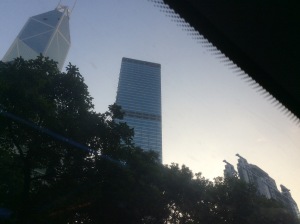 Bank of China (far left) & canon like structure on HSBC roof (far right – view from tram)
Bank of China (far left) & canon like structure on HSBC roof (far right – view from tram)And looking out over the harbour from a ferry you can see the holes in the buildings in Repulse bay on the Eastern coast of Hong Kong – these provide the dragons an unobstructed path to the water, so that the winds of positive energy continue to flow through the city.
 Spot the dragon holes – behind the red Macau ferry
Spot the dragon holes – behind the red Macau ferry


The Sunshine Tree ( Cassia surattensis) or ‘scrambled egg tree’ as it is also known is a beautiful evergreen tree with flowers every month of the year. There are around 500 species of cassia trees and they are renowned for their bright yellow blooms. Another cassia – The Golden Shower tree ( cassia fistula) contains the national flower of Thailand. I recognise the word ‘cassia’ as I recently hunted down cassia bark in my local spice shop which is a cinnamon substitute I use in making indian curry. The trees are part of the Legume family and appropriately I have read that the flowers are often eaten as vegetables by Indian hill tribes.
The leaves closing at night – said to reduce water and energy loss – is appropriate as they wake up to the glorious Summer sunshine in Hong Kong.
The Incense Tree ( Aquilaria sinensis) in the second photo above, is marked with a tag saying ‘an old and valuable tree.’ I have learned that they used to be prolific here as Hong Kong or ‘Fragrant Harbour’ was named after its incense trees. They are aptly named as they were ( still are) prized for their resin contained within their agarwood bark. The resin was originally used in Chinese medicine as a good painkiller. These days, often referred to as ‘liquid gold’ the now rare resin is highly prized and distilled to make oud oil which is an essential ingredient of the most expensive perfumes.



The beautiful fragrant deep pink orchid (bahunia blakeana) of this tree also caught my eye in the park. Walking through the streets of Hong Kong you see the symbol of the orchid everywhere. It is the flower emblem of Hong Kong and first appeared on the Hong Kong coat of arms, flag and coins after the handover from the British to the Chinese at midnight on July 1st 1997 – 20 years ago.
I recently visited this square where the handover ceremony took place. The giant orchid sculpture glistens with pride.

The flower was named after a Hong Kong governor – Henry Blake, a keen botanist. The fact that this flower is unique to Hong Kong, being originally discovered here seems very appropriate. The harmonic red and white design on the flag symbolises ‘one country, two systems’ and I certainly feel the warmth and harmony between the British and Chinese here. Just walking through the park people smile and are friendly to each other. Apart from the current lovely weather it does almost feel home from home.
As our garden thermometer showed it to be 45 degrees in the recent heatwave I felt a bit sorry for our bees and dug our sun umbrella out of the shed and gave them a bit of shade.
 Sunny hive
Sunny hiveThe temperature in a hive is maintained at around 35 degrees – even in winter. But anything above that the bees start fanning with their wings and collect water. You can see them fanning at the entrance and often they gather in clumps outside.
It was a glorious but cooler day back in May when the Spring walk around Roath Park took place and to go back to that now seems a bit crazy but all the blame lies with Terry and Malcolm. They just didn’t stop throwing out the facts and figures and made it far too interesting so I am determined to do as promised and follow on with ‘part two’ if I can make sense of the notes I jotted down.
And it’s a graceful start – with the pinus patula – a Mexican beauty with its hanging green locks and salmon pink bark which apparently smells of aniseed when cut.
 Pinus patula
Pinus patulaIt has five needle clusters and when its cones ( which are its flowers) are rubbed they issue a fine dust.
As we walk out of the ‘secret garden’ opposite the Acer’s we stop to admire beautiful examples of the Mahonia shrub. Originating in Asia the flowers are individually small and bell-like in shape, flowering either on long racemes, or on short, congested ones. The bees love the nectar and pollen they provide and the flowers are often followed by tiny plum-coloured fruits, which are loved by birds.
 Mahonia
MahoniaSo having walked for some time through the park you really do begin to feel the wonders of those who have gone before you and planted such gems. We should cherish their work for future generations despite the cut backs due to money that the council are enforcing. Cardiff council need to look at the bigger picture and invest in what makes Cardiff special. Thanks to Terry and Malcolm their enthusiasm is being passed on and everyone on the walk is becoming equally enthused. – the trees here are full of stories such as the one we now pass which ‘Malcolm explains is known as the tree for sailors… It is called Drimys Winteri or Winter’s bark and it was discovered by a sea Captain – John Winter – as far back as 1557 who used its aromatic bark to treat scurvy. Scurvy was the bane of sailors’ lives – causing millions to die – and the root cause was the lack of vitamin C.
It is also said that Sir Francis Drake himself drank tea made from the same bark to help with stomach problems. If you crush its leaves they have a peppery smell. It flowers in early Summer –
One of the main botanists planting here in the botanic gardens was Pettigrew and Terry explains that he grew the Davidia involucrata from seed.
It also known by the names of the handkerchief tree and the ghost tree and it is easy to see why.
There is a Wales’ champion of this tree in Bute Park – Bute Park handkerchief champion
And to end this tour with a more natural sun umbrella than the one I began with – and the final tree of the tour – is the queenly Cut Leaf Beech. She stands proudly on the corner of the rose garden greeting those who make their way to the rows of memorial benches.
Malcolm points out that a few of the branches have normal beech leaves as the new growth reverts back to its original species….


The new branches point us in the direction of the tea rooms so off we go to refresh our bodies. Our brains having been more than refreshed by Terry and Malcolm’s tree wisdom.
We are well into June – so this is a bit of a retrospective – in fact exactly a month ago today! – but as with all walks in the company of Terry Davies and Malcolm Fraser, their annual Tree Walks are very memorable and should be compulsory in everybody’s diary!

Having spent the week prior to this immersed in my daughter’s offer of a permanent job in Hong Kong it was appropriate that Asia featured highly on the agenda.
It was a chance to de-stress with these two horticultural therapists whose in depth knowledge of trees and shrubs in Roath Park’s botanic gardens is both stimulating and soothing.
Running late as usual I caught up with them standing in the sunshine pointing out the aptly named Chilean Lantern tree from South America. Its’ beautiful perfectly formed red lantern-like flowers are bountiful and you immediately feel a sense of satisfaction at the privilege of seeing it in all its beauty hidden away in the borders opposite the cherries and rose garden.

Its’ neighbour, dressed in another bright primary colour – is the yellow-flowered Barberry from Turkey – a country which straddles the continents of Europe and Asia.

Alleged to have come from Judea in Asia minor is a tall willowy Judas tree covered in bright pink. With its perfectly formed heart shape leaves it is not surprising that it is also known as a Love’ tree.
Some say its’ name ‘Judas tree’ derives from the myth that it was the tree from which judas iscariot hanged himself.
Looking very cool in the background nearby and coming from from cooler central China is a large leaved architectural plant called the Loquat. It fills a space in the border quite unobtrusively. It has white flowers in late Summer and would normally fruit later in the year but not in this country.
The leaves are about a foot long and a gorgeous rich dark green with a white slightly furry underside.

Turning to walk alongside the borders of the rose garden we pass 50 year old bushes with their roots surfacing in the poor soil. Andy and Anne Bell’s website is such a treat – read here about the – Rose Garden history with photos
My favourite roses are two red climbers – Ena Harkness & Dublin Bay, both of which are at the far end of the rose garden.

Moving further along the border is another thorny plant – a hardy spiky shrub from Uraguay and Brazil, called Colletia Paradoxa Which is alsoknown by the descriptive names of ‘crucifixian thorn’ And ‘jet plane ‘ plant!


We learn that they grow strongly and are never damaged by frost. Their white flowers in September and October are strongly scented and are useful for insect pollinators.
Within sight of this rare ‘leave me alone’ type of plant is the beautiful feathery ‘look at me’ pink of the Tamarisk Tree from North Africa- it is gales resistant and often found near the seashore as it can be used to stabilise sand dunes, enjoying a high salt content soil.

It is a lot to take in and Terry speeds up the process by mentioning three trees in one breath….the first is the from Asia – the white Himalayan Birch from China standing next to two trees from the USA – the Kentucky Coffee Tree and the large leavedMagnolia Maceophylla which can have leaves of up to 3 feet long and white flowers up to 14 inches across.
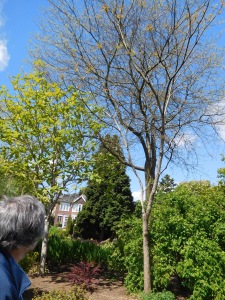

Further along on the corner is the Kaki tree – also known as the Chinese ( or Japanese) persimmon. It is native to China, Burma and India and this particular tree was planted in memory of the Italian Head Gardener of Roath Park – Giovanni. Terry remembers him well and his stories of his home town near Naples. He used to enjoy relating the tradition of how when someone got married in Italy two trees would be planted either side of the new couple’s home – a peach and a persimmon. He loved eating the orangey fruit which were always best when allowed to riped fully on a warm windowsill. They are quite astringent and not to everyone’s taste. The trade name for the non-astringent variety is sharon fruit.

The Friends of Roath Park facebook page – fRiends of Roath Park has a picture of the Magnolia Denudata – or Lily Tree in all its’ March glory. Its’ flowers were regarded as a symbol of purity in the Chinese Tang Dynasty. It was planted in the grounds of the Emperor’s palace and is the official flower of Shanghai.
Another tree nearby is the Magnolia Acuminata from the USA which is also known as the Cucumber Tree due to the shape of its fruit.
So onwards and with leaves similar to a Mountain Ash, the Yellowhorn is a very attractive bush, or small tree. It bears sprays of elegant white flowers on bare branches in May or June.

It’s coming to the end of May and our bees are at their busiest bringing in nectar and pollen from the surrounding urban gardens and up to three miles away from Roath botanic gardens and the nearby allotments at Colchester Avenue.
I think back to early Spring and the glorious tones of lilac heather I walked past at the entrance to the National Trust’s Dyffryn gardens back in early March.

The flowering winter heather (erica varieties) together with the primrose, snowdrops and chinodoxa dotted amongst the rockeries at Dyffryn signal the beginning of Spring and coax the hibernating honey bees out of their winter hives to start foraging for nectar and pollen. It is amazing to think that honey bees will visit a million flowers just to make a pound of honey.
The taste of honey varies according to the types of flowers the bees visit and it this is reflected in the colour of the honey too. If the bees have been collecting from horse chestnut trees, the honey can be dark. So too is the Ling summer heather honey very dark – and an acquired taste. Our honey tends to have a lot of clover and fruit tree pollen in it so is quite light in colour.
White, yellow and violet blue are bees’ favourite colours – and it is interesting to know that bees see the primary colours of red, blue and green as ultraviolet light, blue and green. They don’t see the colour red at all – just tones of red – oranges and yellows.. I have just started a course in watercolour painting and so I am beginning to appreciate more the varying tones, shades and theory of colour!
I spent most of early Spring – March and April – in County Westmeath in Ireland – and so watched the budding and flowering of some of my favourite fruits – damson, sloe and gooseberry.
I made sure I made a note of where the sloes were in flower in the area as when I return in Autumn it will be easy pickings for potent sloe wine and I can put to good use my grand collection of jam jars, kindly donated by friends. Damson jam is one of my favourites and although you need a lot of patience to pick out the stones as they float up amidst the bubbling purple in the pan as it reaches setting point, it is well worth the effort.
Although we don’t have bees on the Irish land ( we intend to) yet we have some lovely trees by the side of Lough Lene including a favourite outstretched beech which provides a warm welcome to all who visit at the gate. When we arrived the last of its prickly nut shells (which did contain mast) were still clinging onto its branches but day by day the new buds began to appear. It was fascinating watching the Magpies to-ing and fro-ing to their nest built at the very top of the tree which was easy to see without the leaves masking it. At dusk bats would swoop in circles above its branches and above the still waters of the lake.

Although getting on in age – maybe a hundred years or so – our beech can’t compete with the specimen marked as ‘ the oldest in our valley’ on the nearby circular walk around Fore abbey which is just over the hill.
It is said that a row of beech trees were planted at the local Tullynally castle specifically to block the view of the distant hill where hanging took place in Fore. You pass ‘hangman’s hill’ on the circular walk around Fore (where the old beech tree is) and at the end of the walk you reach the ruined gaol from where the guilty men spent their last hours. It is next door to my favourite pub of all time – the Seven Wonders Bar.

The pub’s name reflects the seven wonders – or miracles – that Saint Feichin, the local saint who founded Fore abbey in the 7th century – and whose name is given to the local primary school and parish church – is said to have performed.
The first miracle is the Spring that came gushing up from the earth when St Feichin struck the parched ground with his crozier and this spring was then able to feed the mill – ‘the mill without a race’.
He (2) built the monastery upon this marshy ground – or bog and (3) the underground flow of water here appeared to flow uphill to the Mill and past (4) the Ash tree – shaped like the Trinity with its’ three branches – that wouldn’t burn ( surviving terrible fires that occurred at the abbey).
The final three miracles listed are – (5) The water that doesn’t boil – (the water within St. Fechin’s well), (6) the anchorite in a cell – the hermits who occupied the anchorite’s cell and finally (7) the huge lintel-stone above the doorway of the ruined church opposite the abbey – raised by St. Fechin’s prayers alone.
It is worth a pint of guinness ( the best in Ireland) to toast such a hard working Saint.
.
.